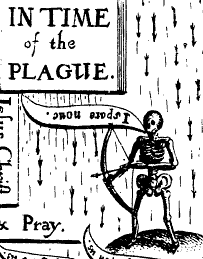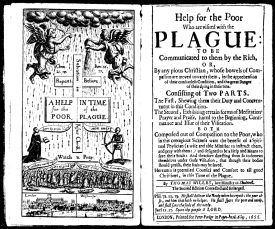 I’m nearly finished with Neal Stephenson’s mammoth novel
I’m nearly finished with Neal Stephenson’s mammoth novel
Some of the most gripping scenes of the novel occur in London in 1665, when the city was ravaged by the bubonic plague. Over 100,000 Londoners died that year (6,000 deaths a week at the plague’s peak). To the right is a detail from the frontispiece of a book published in London a year later, called “A Help for the Poor Who Are Visited with the Plague.” Written by a clergy, Thomas Willes, the book captures the full horror of the plague: I spare none, says the skeleton Death (whose dyslexia only adds to the eeriness of the image).
I’ve always been fascinated by plague narratives, and to judge from popular culture, so is everybody else. Plague–which could be any deadly, contagious biological epidemic–makes for good disaster films (28 Days Later, Dawn of the Dead), as well as fiction (going back to the 14th century and Boccaccio’s The Decameron and up to and through Stanley Kim Robinson’s alternative history of the world
Below is the rest of the woodcut from the frontispiece of Willes’ plague work (click the image for a larger version). From the illustration you can see something else about plagues: so often they are imbued with religious meaning. Salvation, redemption, sanctification–these are the counterweights to destruction, disease, and death. And this is as true today as it was in the days of the Black Death of England. Just listen to the prevailing rhetoric of war…
